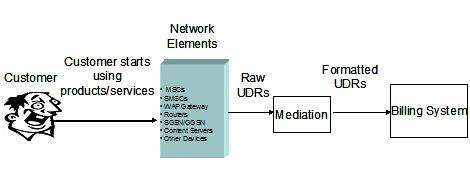
- Telecom Billing Tutorial
- Telecom Billing - Home
- Telecom Billing - Introduction
- Telecom Billing - System Architecture
- Telecom Billing - Products & Services
- Telecom Billing - Tariff Planning
- Customer Acquisition
- Telecom Billing - Usage Capturing
- Telecom Billing - Rating Processes
- Telecom Billing - Processes
- Telecom Billing - Discount Application
- Telecom Billing - Invoice Generation
- Telecom Billing - Credit Control
- Telecom Billing - Collection Process
- Telecom Billing - Payment Processing
- Disputes & Adjustments
- Telecom Billing - Reports Generation
- Advanced Telecom Billing Topics
- Pre-Paid vs Post-Paid
- Retail Billing
- Interconnect Billing
- Roaming Billing
- MVNO Billing
- Convergent Billing
- Support & Maintenance
- Telecom Billing - System Interfaces
Telecom Billing - Usage Capturing
A customer starts generating usage at Network as soon as he/she starts using the products and services sold by the operator. A network element is a combination of software plus hardware and responsible for overall service control and metering events for any type of service.
What is an Event?
An event is a single billable occurrence of product usage, typically captured electronically by a network. For example, when a mobile phone user makes a telephone call, an event is generated, which contains information about that phone call, such as the call duration, the time of day the call was made, and the number that was called.
What is a CDR?
An event along with all its attributes is called Call Detail Record (CDR). A data collector in the network switch captures the usage in the form of Call Detail Record (CDR)/Usage Detail Record (UDR). These raw CDRs/UDRs are in turn converted by the mediation system into a format understandable by the Billing System.
There could be different network elements controlling the services and producing different types of CDRs; for example, for GSM telephony −
- Voice calls are captured by the MSC (Mobile Switching Centre).
- SMS traffic is captured by the SMSC.
- Data traffic is captured by the GGSN.
- MMS traffic is captured by the MMSC.
- Roaming CDRs are captured by roaming partner's switching element.
For more information on GSM, MSC, SMS, SMSC, GGSN, MMS, MMSC, please refer to our GSM tutorials.
The following diagram shows the Network elements capturing Usage data and sending Raw UDRs to the Mediation System and finally to the Billing System for rating and billing.

CDR Attributes
As mentioned above, a CDR keeps usage details along with various other useful information. Below are the most important attributes of a CDR −
Calling Party (A number).
Called Party (B number).
Call Start (date and time).
How long the call was (duration).
Call Type (Voice, SMS, Data etc).
A unique sequence number identifying the record.
Additionally, a CDR may also record other information such as −
The identifier of the telephone exchange.
The result of the call (whether it was answered, busy, etc.).
Trunk or route used to connect the call.
Any fault condition encountered.
Indicators that note the use of features such as call forwarding, three-way calling, etc.
Any facilities used during the call, such as call waiting or call diversion.
Various other attributes depending on requirement.
The accurate recording of all required information in a UDR depends on the logic of the switch vendor plus the switch specific table entries. If either of these cannot record the data accurately, the mediation system will not be able to recognize the completed calls and pass them to the billing system.
CDR Processing
The Mediation System collects CDRs from different network elements in different formats. Various network elements generate CDRs in ASN.1 format and some network elements have their own proprietary format of CDRs.
The Mediation System processes all the CDRs and converts them into a format compatible to the down stream system, which is usually a Billing System. The Mediation System applies various rules on CDRs to process them; for example, mediation system marks the international calls based on the dialed number (B-Number), same way mediation system marks the on-net calls based on A-Number and B-Number.
There may be a requirement to filter out all the calls, which are having call duration less than 5 seconds, the best place to filter out such types of calls will be at Mediation System level. Same way, if some extra information is required in the CDRs, which is critical to billing, then Mediation System will help in providing such information based on some other attributes available within the CDRs.
Once the collected CDRs are processed, Mediation System pushes all the CDRs to the Billing System using FTP because usually Mediation and Billing systems run on different machines.
What is Next?
Well, now you have captured customer generated usage. The next chapter will cover how we can rate this captured usage so that due revenue can be collected from the end-user.